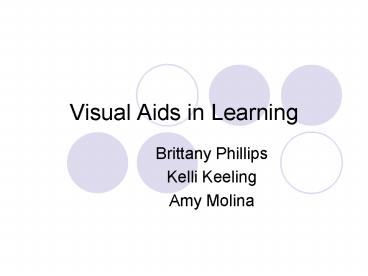Visual Aids in Learning - PowerPoint PPT Presentation
1 / 14
Title:
Visual Aids in Learning
Description:
Title: Visual Aids in Learning Author: Brittany Joy Phillps Last modified by: D Created Date: 1/31/2006 6:11:54 PM Document presentation format: On-screen Show – PowerPoint PPT presentation
Number of Views:358
Avg rating:3.0/5.0
Title: Visual Aids in Learning
1
Visual Aids in Learning
- Brittany Phillips
- Kelli Keeling
- Amy Molina
2
Visual Literacy
- Visual literacy is acquired through many teaching
and learning processes that children experience. - No matter the content, how you design, arrange
and present what you teach it will have a
positive or negative affect on the visual
literacy skill set. - Clarity and consistency will help build skills.
3
Visual Communication
- Every visual consists of three primary elements
in a deliberate arrangement - Visual
- Text
- Affective
- Arranging these effectively can overcome
communication barriers such as sensory, cultural,
and learning style.
4
Visual Guidelines
5
Good Visual Desi gn Poor Visual Design
- Balanced design
- Legible text
- Minimal letter styles and sizes
- Appealing colors
- Provides unity and direction
- Consistent and cohesive
- Relevant images
- Design lacks balance
- Text style difficult to read
- Too many letter styles
- Minimal color appeal
- Lacks unity and direction
- Inconsistent look
- Images disconnected
6
Non-projected Visuals
- Real objects- help address kinesthetic learning,
any objects that can be brought into the
classroom for examination. - Models- 3-D representations cannot be reasonably
brought into classroom but provide an object to
be studied. - Exhibits- include dioramas and class displays
that are created to illustrate instructional
content.
7
Digital Projectors
- Images shown on a digital projector can be
captured with a digital still camera, a digital
video camera, from an analog videotape using a
video capture card, or even from an electronic
smart board. - Teaching and learning will continue to be
visually enhanced through application when
teachers learn more about the technology and
schools increase their acquisition.
8
Document Printing
- -This is a video camera mounted on a stand that
captures and projects an image of whatever is
placed on the stands document table. - -Using top back lighting on the table and the
video cameras zoom features, overhead
transparencies, slides, documents, and 3-D
objects can all be projected to a large group.
- Advantages
- Science experiments, small real objects, and
procedural presentations can be easily shared. - As a teacher gives a live demonstration the small
details can be seen by the students. - Teachers no longer need to walk around the room
with demos because this machine will do it for
them.
9
Interactive Multimedia Elementary
- Trip to the zoo!
- Capture by pictures which then can be made into
transparencies, posters, story books, etc. - Students can make their own recordings of sounds
for animals or comment on other sensory
impressions. - After reviewing kids can add pages of text that
provide facts about each animal and its habitat
as well as other graphics from clip art or their
own drawings.
10
Interactive Multimedia Secondary
- Use multimedia software, learners can work in
teams to investigate and act out alternative
scenarios to resolve a conflict. - Students can use a digital camera to capture the
setting of the conflict and the players involved,
and create navigation buttons to jump to
alternate resolution options. - Each option screen can offer either pictures,
text, and student audio recordings describing the
option and the possible outcome if that option is
taken.
11
Why use visual technology?
- Allan Paivio conducted studies which led him to
develop a theory explaining that humans use two
processes to absorb input. - Lagogens-verbal entities used to absorb verbal
input - Imagens-visual entities used to absorb visual
imput - When input is processed one or both of the
subsystems are engaged, depending on type of
input. This is known as the theory of dual
coding. - When lagogens and imagens are both used to
present input, memory performance was better.
12
Graphics
- Some examples of graphics are as follows
- Cartoons Drawings Diagrams
13
Traditional Visual Resources
- Bulletin boards - Can display both print or
graphic visuals and numerous other resources to
create an effective instructional display. - You may use a computer and desktop publishing
software to create visuals for use on magnetic
boards, felt boards, whiteboards, or even
chalkboards. - Overhead Projectors - Color or black ink can be
used to create transparencies from a computer via
a printer, or photocopied. Ink-jet or laser
printers will create permanent transparencies.
14
Resources
- DEMCO, (n.d.). Equipment. Retrieved Feb. 01,
2006, from http.//www.demco.com - Lever-Duffy, J., McDonald, J., Mizell, A.
(2005). Teaching and learning with technology.
2nd ed. Pearson.































